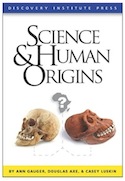 Evolution
Evolution
 Human Origins
Human Origins
Following Up on the Debate over Science and Human Origins
 Readers of ENV may recall that in the summer of 2012, Discovery Institute Press released a book that I co-authored with Doug Axe and Ann Gauger, Science and Human Origins. Larry Moran wasted no time in calling it “another IDiot book,” and others responded with similar substance-free personal attacks. But a few critics attempted thoughtful rebuttals. In fact, the main source for Moran’s comments was a series of reviews of the book by a graduate student in New Zealand named Paul McBride.
Readers of ENV may recall that in the summer of 2012, Discovery Institute Press released a book that I co-authored with Doug Axe and Ann Gauger, Science and Human Origins. Larry Moran wasted no time in calling it “another IDiot book,” and others responded with similar substance-free personal attacks. But a few critics attempted thoughtful rebuttals. In fact, the main source for Moran’s comments was a series of reviews of the book by a graduate student in New Zealand named Paul McBride.
Recently we received an e-mail inquiring about a couple of critical Amazon reviews of Science and Human Origins, one by Paul McBride and another by Jon F. Peters. I told the questioner that I’d seen Paul McBride’s reviews of Science and Human Origins when he posted them last year. They were incredibly weak, and we wrote many responses to him. Here are some of the links I sent:
On Fossils:
- Double Standards and a Single Variable: A Response to Paul McBride’s Review of Fossils in Science and Human Origins
- Read Your References Carefully: Paul McBride’s Prized Citation on Skull-Sizes Supports My Thesis, Not His
- McBride Misstates My Arguments in Science and Human Origins
On Junk DNA:
- A Response to Paul McBride on Junk DNA
- Paper Rebuffs Assumption that Pseudogenes Are Genetic “Junk,” Claims Function Is “Widespread”
- Here Comes McBride (Again): The Debate on Junk DNA Continues
On Population Genetics and Phylogenetics:
- On Retrospective Analysis and Coalescent Theory
- On Population Genetics Estimates
- On Phylogenies and Analogies
On Protein Evolution:
My email correspondent also mentioned an Amazon review by “Jon F. Peters.” I hadn’t seen that one before, but there’s not much there either.
Peters seems to think that the ordering of genes on chromosomes is a functionally meaningless feature that has nothing to do with design constraints. Thus, he thinks the similar ordering of genes on human and chimp chromosomes shows we share a common ancestor. He’s wrong. In fact, loads of research from the past ten years shows that the ordering of genes on chromosomes is very important for regulating gene expression. For a discussion of a recent paper on this, see:
Another point Peters makes has to do with the degenerate nature of the DNA at the alleged fusion site. This is a non-issue. I cited a paper that clearly discussed the degenerate nature of this DNA. The scandal that Darwinians on the Internet have tried to manufacture about this is a joke. Here’s what happened:
- I cited a paper that said the DNA at the supposed “fusion point” has far fewer repeats than it should.
- The paper said exactly what I said it said.
- Ergo no scandal.
To this day I don’t quite understand why the ID-critics got so ruffled over this. Maybe they feel threatened by genetic evidence that isn’t exactly what the fusion story predicts.
That said, from the beginning when I started writing about this in 2005 (see here and here), my main argument has never been that there was no fusion. As I wrote:
So I am more than willing to acknowledge and affirm that Miller did provide some very good direct empirical evidence for a chromosomal fusion event which created human chromosome #2. But I’m more interested in two other questions: if we accept Miller’s chromosomal fusion evidence as accurate, then (1) is his chromosome fusion story good evidence for Neo-Darwinian common ancestry between humans and apes? … The answer to question (1) is “NO.”
I’ve always been very open to the possibility that human chromosome 2 resulted from a fusion. My main argument has been that even if there was such an event, it provides no special evidence for neo-Darwinism or human/ape common ancestry. For more details, see here:
